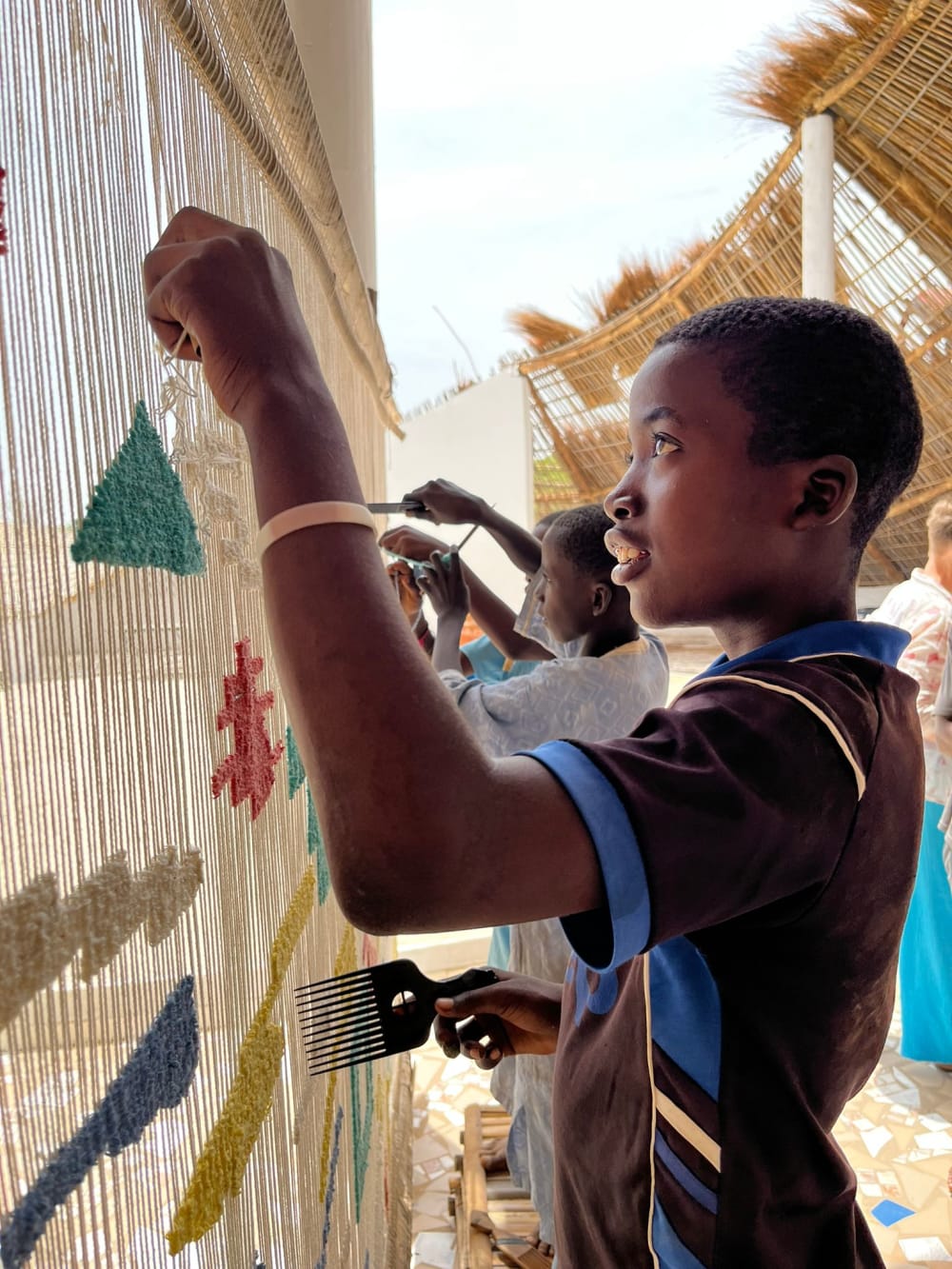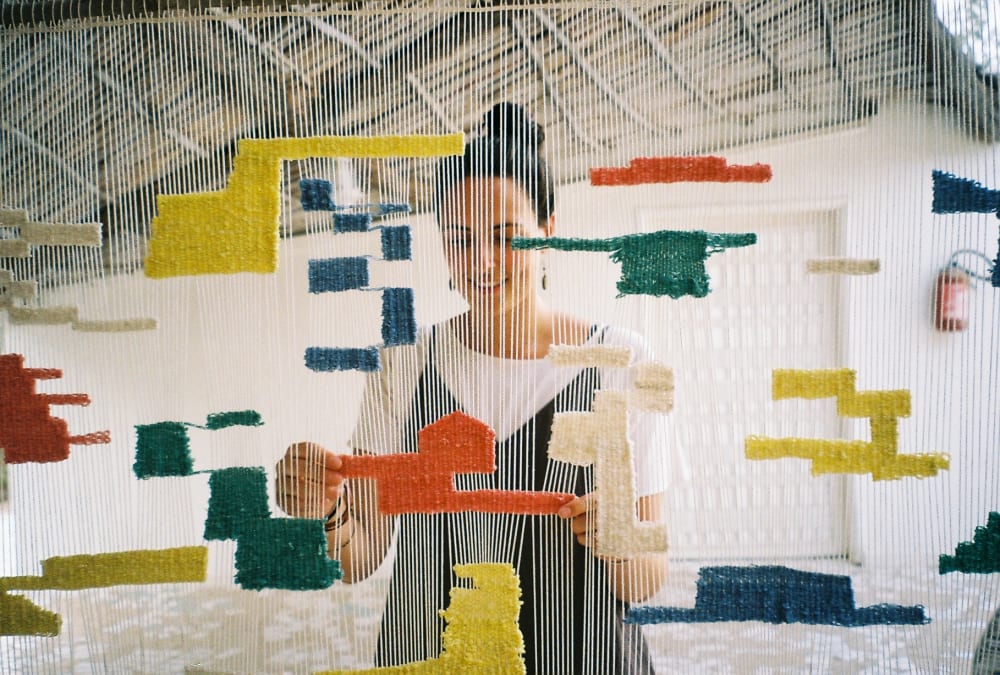Report by Sara Kelly, AER artist in residence at Thread, Senegal, 3 - 27 May, 2022.
Intentions
When I heard about the Thread, Senegal residency, I knew it would be a great opportunity for me to develop my weaving practice in a new environment; the idea of collaboration and knowledge exchange really inspired me to apply. The isolated confinements of the pandemic made it clear to me that I want to prioritise co-creating with communities and further explore the use of Art and Craft as tools for social interaction and knowledge exchange.
Arriving in Sinthian, Tambacounda
“Tamba! C’est très chaud!”; the most common response I received in Dakar when speaking about my upcoming travels to a rural village in the region of Tambacounda (Tamba). I was arriving at the hottest time of the year, just before the impending rainy season, with temperatures soaring to 47°C. The small rural village, Sinthian, is located 60km away from the city of Tambacounda. I arrived at dusk, to the sounds of kids playing football, donkeys braying, and the smells of delicious home cooked Thieboudienne. I was welcomed by Cissé, the Assisting Manager of the Thread Cultural Centre, who showed me to my room: a beautiful thatched building, with bedroom, bathroom and small studio space.


I spent my first days at Thread adjusting to the extreme heat and revelling in the peaceful and calm atmosphere that prevailed there. The midday sun made it almost impossible to work between 12pm – 4pm, so the days moved at a slower pace; starting early and finishing at nightfall. I was faced with the challenging prospect of creating a project using only materials and inspiration from the local area. I visited members of the village, chatted with them and joined them in drinking strong, sweet, Senegalese mint tea. International artists visit here all year round, and the local community welcome them in with open arms. It was clear to me that without this huge local support, the residency programme here would not succeed.
Thread is a socio cultural centre that houses two artists dwellings and studio space for local and international artists. The residency has been running since 2015, however, after the 2020 global pandemic, I was the first artist in residence in over 2 years.

Designed, pro-bono, by Japanese Architect Toshiko Mori, Thread is a hub for Sinthian and the surrounding villages. The space provides agricultural training, community farms, water sources, an exhibition and performance venue, local library, and importantly, the village mobile phone charger. The building’s multifunctionality is a valuable addition to the town’s infrastructure, whilst bringing artistic practices into the heart of the community. When I arrived at Thread, the parametric bamboo thatched roof was being restored and the whole centre was somewhat of a building site.


Nevertheless, even under construction, the building was a hive of activity, which was inspiring to observe. Women from the village gathered there every morning, sweeping and exchanging stories. Children played with each other and used the library. The roof contractors worked every day under the heat of the intense sun, and visitors from other villages came to plan upcoming events.

Experimenting with local materials
I began drawing and painting objects that took my interest: the steel beams of the roof structure, the colourful reclaimed mosaic flooring and the abundance of old bamboo that had been taken down from the roof.
I set about freely experimenting with local resources and accessible materials. Using old bamboo lengths, I built a small frame loom, tied together with scraps of wire found around the site. A group of women in the village spin locally grown cotton. Over the years, the centre has supported the continuation of the craft, buying cotton for use in residencies. This unlikely abundance of material provided the foundation for my work.


At these early stages, I was interested in the relationship between product and tool. In most weaving practices, the loom is only necessary until the woven fabric is cut from it. I wanted to explore ideas of how the loom can be integrated into the final piece, highlighting the making process. I wove organic forms, inspired by the eclectic patterns of the mosaic tiled floors. In this weaving sample, I embraced the space between the forms, which created a piece that was neither transparent or opaque. Meanwhile the roof restoration was in full force, now creating semi shaded areas through the deconstructed rafters of the building.



Language
Unable to speak a common language, it was difficult to communicate with the majority of the population in Sinthian, who speak Pulaar. I was curious to see if the process of making could be used as a supplement to language, and how the process of making textiles could act as a form of tactile and non-verbal communication.
Concept
Next, I wanted to experiment on a larger scale and make a public installation that invites people to participate in and contribute to a single, collaborative piece of work. Collecting materials from the site, lengths of bamboo, wire and a bundle of hand spun cotton yarn, I sketched ideas for a large loom, that would be built into the structure of the cultural centre. There were 2 parts of the roof that were not being renovated, and therefore provided 2 potential sites for intervention.



Unwinding, Dyeing, Drying, Re-winding
On a trip to Tamba, I came across a small boutique that sold an array of powdered dyes. I chose a selection of 4 colours, based on the tiled floor at the cultural centre: red, yellow, green and blue.




The local cotton yarn was extremely fine and delicate. By twisting together 3 strands of yarn, the cotton became stronger and more durable, and provided a thicker weft. This long process of unwinding, dyeing, drying and re-winding, was slow and experimental, and had caught the attention of the local community.




The Loom
I designed a 4.5m x 2.5m bamboo frame loom, using the main structural beams of the cultural centre. Without access to measuring equipment, I hand cut the pieces and installed them by eye. The frame was then held in position and secured to the building using metal wire.



I spent a few days, carefully warping the frame in-situ and sawing small grooves into the loom that would support the warp threads and keep them in place. With help from the roofers, we whittled down pieces of bamboo to use as warp separators and to create the right tension in the warp until eventually the loom was ready to use.



7 days of weaving. 43 weavers.
With support from Cissé, we invited members of the village to talk, gather and weave with me on the community loom. Initially I facilitated open weaving sessions with groups of men, women and children from the village. After a brief explanation of the process I would encourage the participants to pick a coloured cotton bobbin, find a spot on the loom and start weaving. I practiced a light-touch form of teaching, gently guiding the participants through the process of making, encouraging them to weave intuitively and organically.






As an artist, letting go of a vision and releasing control of the project shifted the process of weaving away from the production of an object. Often people would weave tightly, letting the warp threads bunch together which created large gaps in the warp. This then gave the next visitor a different and unique foundation to build up from and interact with; a tangible record of communication from one weaver to the next.
Keeping the forms small and separated meant that participants had the opportunity to start and finish a piece quickly - some stayed for 10 minutes, others for 3 hours.





There was a lot of opportunity for creative expression, to weave organic forms that interacted with each other. The loom was wide enough for up six or more people to work on at one time, and tall enough for people to work at different heights. In between sessions I would add to the tapestry, interacting and responding to their weaving, helping to reform the warp, maintain the loom tension and offer playful interventions. This structure gave us all the freedom to not think about the end goal, and to put more focus on the process. We played music, drank tea, and told stories, whilst sharing a common language of craft. The final tapestry is a story of a shared encounter between 43 people.








Thread Tapestry
Through the residency I created a piece of work that collaboratively created shared experiences within the local community, without having a common language. The result was more joyous than I could have imagined. Through my work I formed relationships, friendships and had fleeting encounters with school children, builders, gardeners and doctors alike.
One of the most rewarding parts of this residency, was the overall response from participants. They expressed a strong willingness and excitement to learn a medium, that for most, was entirely new. Some spoke of the benefits of taking time out of their day to unwind and be creative in a calming environment. Children used the sessions to socialise and play with school friends, taking turns to learn and share their weaving. Others expressed the importance of contributing to a project, that is created by the community, and displayed permanently in the cultural centre; a long-lasting record of their collective efforts.



The tension of the loom radiated through not only the fibres of the tapestry, but into the building it was constructed from, and the village that surrounded it. This work is a testament to the ability of craft to bridge generational and cultural divides, and communicate through tactile exchange and silent knowledges.
The final project, Thread Tapestry, will remain in the cultural centre for the foreseeable future, open to new interventions by both human and nature.



More about the AER Residency
The Art for the Environment Residency Programme (AER) provides UAL graduates with the opportunity to apply for a 2 to 4 week fully funded residency at one of our internationally renowned host institutions, to explore concerns that define the 21st century – biodiversity, environmental sustainability, social economy and human rights.
Founded in 2015, internationally acclaimed artist Professor Lucy Orta, UAL Chair of Art for the Environment – Centre for Sustainable Fashion, launched the programme in partnership with international residency programmes and UAL Post-Grad Community.

